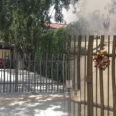
The former Altadena Town & Country Club Golf Course will serve as a staging for the temporary storage of hazardous materials collected from the Eaton fire burn footprint.
The Club itself was destroyed by the Eaton Fire early last month.
According to a lease agreement effective February 8, the U.S. Environmental Protection Agency (EPA) and the County of Los Angeles have signed a lease agreement for the additional staging area at the Altadena Golf Course. This is the third staging area that EPA will use for the materials.
Staging areas have also been established at Farnsworth Park in Altadena and Duarte.
“EPA is working to remove hazardous materials from the burn footprint of the Eaton fire as safely and efficiently as possible,” said Tara Fitzgerald, EPA Pacific Southwest Incident Commander for EPA’s Emergency Response to the Los Angeles Wildfires. “Securing this third staging area in Altadena means that EPA will be able to move more hazardous materials from an uncontrolled environment into a controlled environment daily to allow residents to move through the recovery process as quickly as possible.”
The Eaton Fire broke out on Jan. 7 and destroyed 9,000 structures and burned more than 14,000 acres. Seventeen people died as a result of the fire.
FEMA assigned the EPA to assess, remove, and safely dispose of hazardous materials from all burned areas as part of the largest wildfire hazardous waste cleanup in the agency’s history.
In order to this, EPA establishes temporary staging areas where hazardous materials collected from the fire burn footprints are consolidated and repackaged in a controlled environment for safe transportation to final disposal facilities.
Without a staging area, EPA would not be able to continue collecting hazardous materials, which is the necessary first step for the fire-impacted residents of the Eaton fire area to begin recovery from the devastating fire.?Securing this third staging area is critical for EPA to meet its accelerated timeline for finishing Phase 1 household hazardous waste removal operations.
EPA implements significant safety and mitigation measures to ensure the public and the environment are not negatively impacted by the temporary staging areas. EPA is installing fencing to prevent any unauthorized entry and will establish a minimum buffer zone that surrounds the staging area.
Additional mitigation measures across all staging areas includes, rre-sampling of the area to establish current conditions, lining processing areas with plastic and installing protective measures such as wattles, booms, earthen berms and gravel, continuous perimeter air monitoring for site and worker safety, spraying water three times daily to control dust from vehicle traffic, transporting all materials safely from the burn area to the staging area following Department of Transportation standards and packaging and removing waste from the site nearly daily, without ground contact.
After Phase 1 is complete, the EPA will test the area again to confirm no negative impact to the environment.














 4 comments
4 comments


